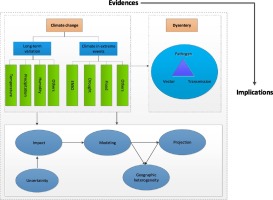当前位置:
X-MOL 学术
›
Sci. Total Environ.
›
论文详情
Our official English website, www.x-mol.net, welcomes your feedback! (Note: you will need to create a separate account there.)
Impact of climate change on dysentery: Scientific evidences, uncertainty, modeling and projections.
Science of the Total Environment ( IF 9.8 ) Pub Date : 2020-01-15 , DOI: 10.1016/j.scitotenv.2020.136702 Xiaoxu Wu 1 , Jianing Liu 1 , Chenlu Li 1 , Jie Yin 1
Science of the Total Environment ( IF 9.8 ) Pub Date : 2020-01-15 , DOI: 10.1016/j.scitotenv.2020.136702 Xiaoxu Wu 1 , Jianing Liu 1 , Chenlu Li 1 , Jie Yin 1
Affiliation

|
Dysentery is water-borne and food-borne infectious disease and its incidence is sensitive to climate change. Although the impact of climate change on dysentery is being studied in specific areas, a systematic review is lacking. We searched the worldwide literature using three sets of keywords and six databases. We identified and selected 98 studies during 1866-2019 and reviewed the relevant findings. Climate change, including long-term variations in factors, such as temperature, precipitation, and humidity, and short-term variations in extreme weather events, such as floods and drought, mostly had a harmful impact on dysentery incidence. However, some uncertainty over the exact effects of climate factors exists, specifically in the different indexes for the same climate factor, various determinant indexes for different dysentery burdens, and divergent effects for different population groups. These complicate the accurate quantification of such impacts. We generalized two types of methods: sensitivity analysis, used to detect the sensitivity of dysentery to climate change, including Pearson's and Spearman's correlations; and mathematical models, which quantify the impact of climate on dysentery, and include models that examine the associations (including negative binomial regression models) and quantify correlations (including single generalized additive models and mixed models). Projection studies mostly predict disease risks, and some predict disease incidence based on climate models under RCP 4.5. Since some geographic heterogeneity exists in the climate-dysentery relationship, modeling and projection of dysentery incidence on a national or global scale remain challenging. The reviewed results have implications for the present and future. Current research should be extended to select appropriate and robust climate-dysentery models, reasonable disease burden measure, and appropriate climate models and scenarios. We recommend future studies focus on qualitative investigation of the mechanism involved in the impact of climate on dysentery, and accurate projection of dysentery incidence, aided by advancing accuracy of extreme weather forecasting.
中文翻译:

气候变化对痢疾的影响:科学证据,不确定性,模型和预测。
痢疾是水传播和食源性传染病,其发病率对气候变化敏感。尽管正在特定地区研究气候变化对痢疾的影响,但仍缺乏系统的审查。我们使用三组关键字和六个数据库搜索了全球文献。我们在1866-2019年期间确定并选择了98项研究,并回顾了相关发现。气候变化,包括温度,降水和湿度等因素的长期变化,以及洪水和干旱等极端天气事件的短期变化,大多对痢疾的发病率产生有害影响。但是,对于气候因素的确切影响存在一些不确定性,特别是在相同气候因素的不同指标,针对不同痢疾负担的各种决定性指标,以及对不同人群的不同影响。这些使这种影响的准确量化变得复杂。我们概括了两种类型的方法:敏感性分析,用于检测痢疾对气候变化的敏感性,包括Pearson和Spearman的相关性。数学模型可以量化气候对痢疾的影响,并包括检查关联的模型(包括负二项式回归模型)和量化相关性(包括单个广义加性模型和混合模型)。投影研究主要预测疾病风险,而一些研究则根据RCP 4.5下的气候模型预测疾病发生率。由于气候与痢疾之间存在某些地理异质性,在国家或全球范围内痢疾发病率的建模和预测仍然具有挑战性。审查结果对现在和将来都有影响。当前的研究应扩展到选择合适的,健壮的气候痢疾模型,合理的疾病负担测度以及合适的气候模型和情景。我们建议未来的研究重点是定性研究气候对痢疾的影响所涉及的机制,并通过提高极端天气预报的准确性来准确预测痢疾的发病率。
更新日期:2020-01-22
中文翻译:

气候变化对痢疾的影响:科学证据,不确定性,模型和预测。
痢疾是水传播和食源性传染病,其发病率对气候变化敏感。尽管正在特定地区研究气候变化对痢疾的影响,但仍缺乏系统的审查。我们使用三组关键字和六个数据库搜索了全球文献。我们在1866-2019年期间确定并选择了98项研究,并回顾了相关发现。气候变化,包括温度,降水和湿度等因素的长期变化,以及洪水和干旱等极端天气事件的短期变化,大多对痢疾的发病率产生有害影响。但是,对于气候因素的确切影响存在一些不确定性,特别是在相同气候因素的不同指标,针对不同痢疾负担的各种决定性指标,以及对不同人群的不同影响。这些使这种影响的准确量化变得复杂。我们概括了两种类型的方法:敏感性分析,用于检测痢疾对气候变化的敏感性,包括Pearson和Spearman的相关性。数学模型可以量化气候对痢疾的影响,并包括检查关联的模型(包括负二项式回归模型)和量化相关性(包括单个广义加性模型和混合模型)。投影研究主要预测疾病风险,而一些研究则根据RCP 4.5下的气候模型预测疾病发生率。由于气候与痢疾之间存在某些地理异质性,在国家或全球范围内痢疾发病率的建模和预测仍然具有挑战性。审查结果对现在和将来都有影响。当前的研究应扩展到选择合适的,健壮的气候痢疾模型,合理的疾病负担测度以及合适的气候模型和情景。我们建议未来的研究重点是定性研究气候对痢疾的影响所涉及的机制,并通过提高极端天气预报的准确性来准确预测痢疾的发病率。



























 京公网安备 11010802027423号
京公网安备 11010802027423号